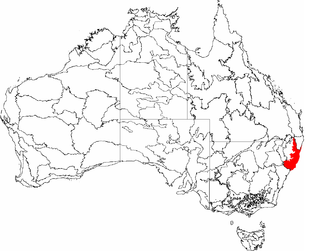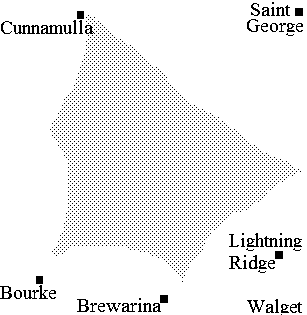History of contact
The explorer Thomas Mitchell, during his expedition to find a route to the Gulf of Carpentaria, surveyed the area of the Culgoa and Balonne Rivers in 1846, relying on a Wiradjuri guide and interpreter Yuranigh. At the same time, In 1845 his son Roderick Mitchell, who was Commissioner of Crown Lands, on hearing stockmen's reports of rich pasturage in the area, began mapping it. By 1850 regulations allowed settlers to take up 50 square miles (130 km2) of land on 14 year leases. Conflicts arose over land use, and several massacres and killings took place in the following years.
Many Muruwari attached themselves to established stations, working there except for specific periods when ritual duties or "going bush" led them to take leave: newspaper reports at the time single out Thomas Caddell's Tatala run, managed by Frederick Wherritt, as a station where relations were conducted "with tact and humanity". Wherritt's approach paid off: several hundred sheep were saved in the 1861 flood when the local blacks rescued them by herding them up to the one piece of high dry ground in the area.
The Bakanambia, also known as the Wanbara, are an Aboriginal group of Australia. Traditionally, the Bakanambia lived in the vicinity of Princess Charlotte Bay in the state of Queensland. One of the ethnonyms applied to them was Lama Lama, which is now used of a larger aggregation of remnants of several tribes.
The Kooma are a contemporary aggregation of Indigenous Australian peoples descending from tribes living in the border region of Queensland and New South Wales. They are descendants of the Koamu.
Wanggamala, also spelt Wanggamanha, Wangkamahdla, Wangkamadla, Wangkamanha, Wangkamana, Wonkamala, Wongkamala, Wonkamudla, and other variants, is an extinct Australian Aboriginal language of the Pama–Nyungan family, previously spoken in the Northern Territory around Hay River and to the south of the Andegerebinha-speaking area.

Barranbinja or Barrabinya is an extinct Australian Aboriginal language of New South Wales. The last speaker was probably Mrs Emily Margaret Horneville, who was recorded by Lynette Oates who then published a short description of it. It had also been recorded by R.H. Mathews along with Muruwari, though not all items in his wordlist were recognised by Mrs Horneville. Both Mathews and Oates conclude that Barranbinya and Muruwari were in a dialect relation.

The Dadi Dadi or Tatitati are an Australian Aboriginal people whose traditional lands are located along the southern banks of the Murray River in Victoria Australia.

The Djangadi, Dainggati, Tunggutti or Dunghutti are an Aboriginal Australian people resident in the Macleay Valley of northern New South Wales.
The Ngaku were an Australian Aboriginal tribe located around the Macleay River of New South Wales. They were a predominantly coastal people. Although their language was not recorded, it was described as a dialect or accent of Dhanggati.
The Barranbinya, also written Baranbinja and other variants, are an Aboriginal Australian people of New South Wales.
The Wanggamala people, also spelt Wangkamahdla, Wangkamadla, Wangkamanha, Wangkamana, Wonkamala, Wongkamala, Wonkamudla, and other variants, are an Aboriginal Australian people of the Northern Territory and Queensland.
The Pitapita or Pitta Pitta are an Aboriginal Australian people of the state of Queensland.
The Julaolinja were an indigenous Australian people of the state of Queensland.
The Yangga, also spelt Jangga, were an Aboriginal Australian people of the state of Queensland. They are not to be confused with the Yanga people.
The Yangkaal, also spelt Yanggal, are an Aboriginal Australian people of area of the Gulf of Carpentaria in the state of Queensland.
The Gawambaraay (Kawambarai) are an Aboriginal Australian people of the state of New South Wales, closely connected to the Gamilaraay (Kamilaroi) people. Their traditional lands are in the central–western district of New South Wales

Nyngan Parish, New South Wales is a rural locality of Bogan Shire and a civil parish of Oxley County, New South Wales. a Cadastral divisions of New South Wales.

The Plains Parish, New South Wales is a rural locality of Bogan Shire and a civil parish of Oxley County, New South Wales, a Cadastral divisions of New South Wales.

Buddabadah Parish, New South Wales is a rural locality of Bogan Shire and a civil parish of Oxley County, New South Wales, a Cadastral divisions of New South Wales.

Terangan Parish, New South Wales is a rural locality of Warren Shire and a civil parish of Oxley County, New South Wales, a Cadastral divisions of New South Wales.

Beardina Parish, New South Wales is a rural locality of Warren Shire and a civil parish of Oxley County, New South Wales, a Cadastral divisions of New South Wales.

Dooran Parish, New South Wales is a rural locality of Warren Shire and a civil parish of Oxley County, New South Wales, a Cadastral divisions of New South Wales.




